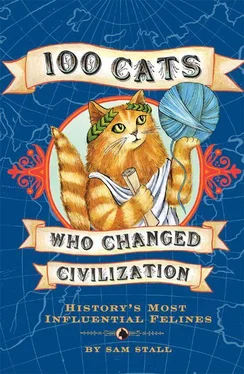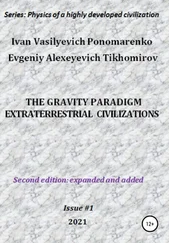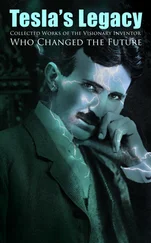It was a merciful finale for the poor creature. Perhaps God—or Mother Nature, or simply fate—realized that a bunch of idiots were tampering with biology’s most elegant design and decided to stage an intervention.
ALL BALL
THE CAT WHO PLAYED WITH A GORILLA

Scientists once believed that the ability to make and use tools was a skill reserved only for humans. Now they’ve realized that creatures from chimps to certain kinds of birds can master this trick. So are there any behaviors that set us apart from the “lower” animals? Perhaps our inclination to keep other species as pets makes us unique.
Or perhaps not.
If the behavior of Koko the gorilla is any guide, other creatures crave this sort of companionship, too. The Woodside, California, resident, born in 1976, is world famous for her “speaking” ability. The scientists who care for her assert that she’s learned more than 1,000 American Sign Language symbols and uses them to communicate everything from her physical needs to her moods.
In 1984, Koko reportedly told her keepers that she’d like to have a pet cat for her birthday present. Shortly thereafter, a litter of abandoned kittens was brought in for her to inspect. After carefully examining each one, she chose a tailless gray male who she named All Ball. Though Koko was of course far larger and much stronger than her fragile new charge, she treated him with great gentleness. All Ball was cuddled, kissed, and allowed to ride around on Koko’s back like a baby gorilla.
Sadly, All Ball escaped from the compound in December 1984 and was killed by a car. Koko was inconsolable. She cried for days and tried to express her loss to her keepers through sign language. When someone asked what happened to her pet, Koko responded by signing “Sleep cat.” And when she was shown a picture of a kitten that looked like All Ball, she signed, “Cry, sad, frown.”
Can a gorilla really communicate using language? Maybe, or maybe not. Some scientists wonder if Koko truly comprehends what she’s doing, or if, perhaps, the words she uses are merely wishful thinking on the part of the handlers who interpret for her. But what’s harder to dispute is the depth of the gorilla’s reaction to her small friend’s death. Koko may or may not be able to sign the word for grief, but she certainly seems to feel it.
SCHRÖDINGER’S CAT
THE MOST ENIGMATIC CAT IN OUR UNIVERSE. OR ANY UNIVERSE, FOR THAT MATTER

For more than a century, physicists have struggled to understand quantum mechanics—the rules governing the behavior of subatomic particles. This is important because the knowledge is essential for everything from nuclear power to computer science to genetic engineering. But it’s also maddening, because these incredibly small objects don’t behave in ways the average person would consider normal. Or even rational.
One of the most bedeviling problems is that while in the “big” universe one can chart the positions of planets and stars based on mathematical formulas, the subatomic world’s behavior can’t be easily predicted. For instance, it is physically impossible to determine both the momentum and precise position of an electron orbiting an atomic nucleus. What this means, in layman’s terms, is that our entire known world is constructed of things that can’t ever be known.
Great minds have expended enormous quantities of chalk and covered numberless chalkboards trying to reconcile the operation of the tiny quantum universe with our “real” world. In 1934, physicist Erwin Schrödinger tried to illustrate those complexities by using, of all things, an imaginary cat.
Schrödinger designed a thought experiment in which an atomic nucleus was used in a game of automated Russian roulette with a theoretical feline. Writing in the German magazine Natural Sciences , he ruminated about what might happen if a cat were placed in a sealed box with a canister of poison gas that was connected in some way to a radioactive atomic nucleus. The nucleus has an exactly 50 percent chance of decaying in one hour. If it does, its radiation will open the gas canister, killing the cat. If it doesn’t decay, the canister won’t open and the cat will survive.
Here’s where things get strange. According to our understanding of quantum mechanics, subatomic particles such as the nucleus could exist in many states at once, until some sort of outside stimulus forced them into one course of action. In the world of quantum physics, the mere act of observation can accomplish this. In other words, someone looking at it could cause the nucleus to stop fluxing between multiple states and, in essence, pick a side. Thus, an observer who opened the box after an hour would find either a dead cat or a live cat.
But what goes on inside the container before the human looks and forces the nucleus down one road or the other? According to some interpretations of quantum theory, inside this Twilight Zone of a box, both things happen at once. The nucleus is both decayed and undecayed, and the cat is both alive and dead. Furthermore, some physicists assert that when the box is finally opened and the results observed, both alternatives continue. Time and space split, and two entire universes shear off from each other—one in which the cat lives, the other in which it dies.
Not surprisingly, Schrödinger’s enigmatic cat has become a feline celebrity among the learned. Sly references show up regularly in science fiction movies and television series such as Dr. Who and Futurama , and writers from Ursula K. Le Guin to Robert A. Heinlein have coopted the feline in their books.
That’s a lot of press for an animal that isn’t real. However, fans can take comfort in the fact that while Schrödinger’s cat doesn’t exist in this corner of the space-time continuum, it may in some other bit of the quantum-ruled Multiverse.

OTHER FELINES OF DISTINCTION
THE FIRST KNOWN DOMESTIC CAT — Discovered by French archaeologists in a 9,500-year-old grave on the island of Cyprus. Near its final resting place sits the grave of (presumably) its human master .
THE DOCTOR’S DEVILS — The nickname of matching black cats owned by eighteenth-century London quack Gustavus Katterfelto, who conned the gullible by displaying “scientific wonders” such as rudimentary electricity tricks. Katterfelto used the static that built up in the cats’ fur to, literally, put the spark in his presentations .
SIZI — The prized pet of physician and theologian Dr. Albert Schweitzer. If Sizi fell asleep on Schweitzer’s left arm, he refused to use that limb until his feline friend moved of her own accord .
TAMA — Created in 2000 by Japan’s Omron corporation, Tama was the first mass-produced robotic feline. Pressure sensors enabled her to detect and react to petting .
THE HYPOALLERGENIC CAT — Recently produced by the San Diego-based company Allerca, these felines are genetically engineered to suppress a protein secretion that causes allergies .
 Читать дальше
Читать дальше















